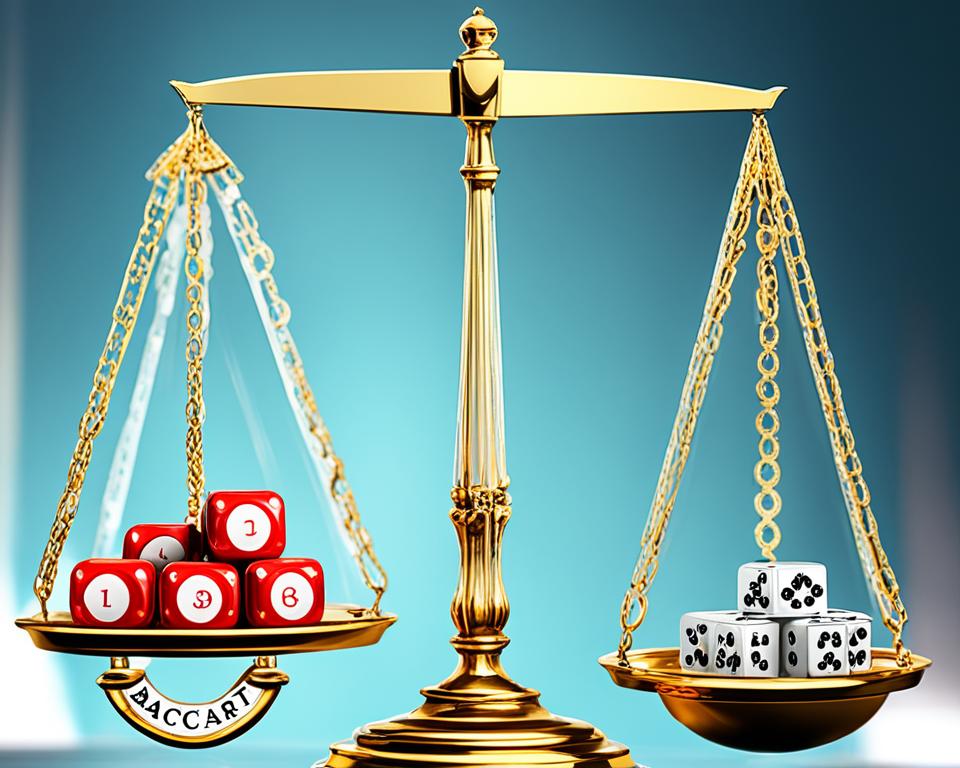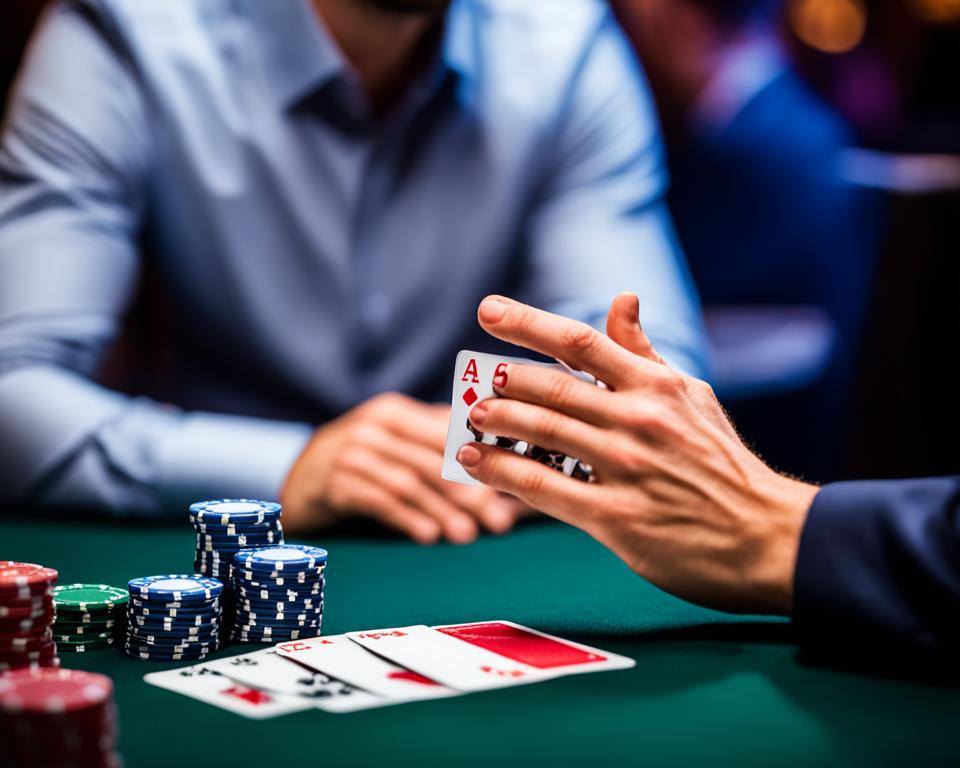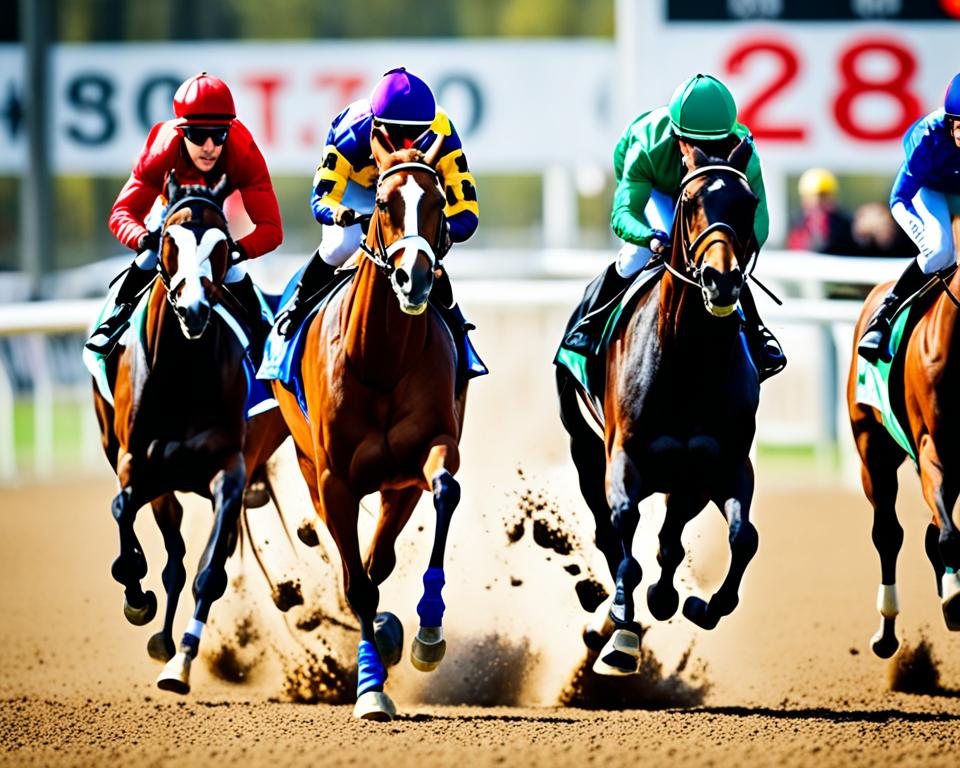Baccarat is a captivating casino game with a rich history, but many players wonder if it can be beaten. This article delves into the truth about the beatabili ty of baccarat, exploring various strategies, card counting techniques, and the house edge. We’ll investigate whether it’s possible to gain a consistent advantage over the casino and unveil the realities of baccarat gameplay. By the end, readers will have a comprehensive understanding of the challenges and potential opportunities in mastering this classic game.
Read interesting things at : trainwithnexus
Key Takeaways
- Baccarat is a game of chance with a relatively low house edge, but it is not easily beatable.
- Card counting and other advanced techniques can provide a slight edge, but they are challenging to execute consistently.
- Bankroll management and emotional control are crucial for any successful baccarat strategy.
- While some players have found ways to reduce the house edge, there is no guaranteed method to consistently beat the casino at baccarat.
- Understanding the game’s probabilities and dynamics is essential for making informed decisions about baccarat gameplay.
Understanding the Game of Baccarat
To fully explore the beatabili ty of baccarat, it’s essential to have a solid grasp of the game’s fundamental rules and gameplay. Baccarat is a card game where players bet on the outcome of a hand, choosing between the Player hand and the Banker hand. The objective is to predict which hand will have a value closest to 9.
Baccarat Rules and Gameplay
The game begins with the dealing of two cards each to the Player and Banker hands. The values of the cards are added, and if the total exceeds 10, the tens digit is dropped. For example, a hand with a 7 and an 8 would have a value of 5 (7 + 8 = 15, dropping the 1). The hand with the value closest to 9 wins, and if both hands have the same value, it results in a tie.
Player Hand vs. Banker Hand
In baccarat, players can bet on the Player hand, the Banker hand, or a tie. The Player hand and Banker hand have slightly different rules for drawing a third card, which can affect the outcome of the game. Understanding these nuances is crucial for making informed bets and evaluating potential baccarat gameplay strategies.
House Edge in Baccarat
The house edge in baccarat is a crucial factor in determining the game’s beatabili ty. The house edge represents the casino’s mathematical advantage over the player, and it varies depending on the specific bet made. For a standard baccarat game, the house edge is around 1.06% for a bet on the Player hand, 1.24% for a bet on the Banker hand, and 14.36% for a bet on a tie. These house edge percentages are important considerations when assessing the potential for beating the casino at baccarat.
Bankroll Management and Discipline
Effective baccarat bankroll management and emotional discipline are crucial components of a successful baccarat strategy. Maintaining a disciplined approach to the game can help players weather the inherent volatility and maximize their chances of long-term profitability.
Setting Bankroll Limits
Before embarking on a baccarat session, it is essential to establish baccarat bankroll limits that align with your overall financial goals and risk tolerance. Determining a pre-set amount that you are willing to wager and strictly adhering to it can prevent impulsive, high-stakes betting that often leads to significant losses.
Avoiding Tilt and Emotional Play
Baccarat, like many casino games, can be susceptible to emotional responses, particularly when experiencing a string of losses. Avoiding tilt is crucial, as it can lead to reckless decision-making and a breakdown in disciplined gameplay. Maintaining a calm, analytical mindset throughout your baccarat sessions is key to making informed, rational choices and minimizing the impact of short-term volatility.
By prioritizing baccarat bankroll management and emotional control, players can position themselves for long-term success in the game of baccarat, weathering the inevitable ups and downs and maximizing their chances of profitability.
Baccarat Card Counting Strategies
While baccarat card counting may initially seem like a viable approach to gaining an advantage in the game, the reality is that it can be significantly more challenging compared to other casino games, such as blackjack. The relatively low number of cards dealt, the rapid pace of play, and the game’s unique mechanics make it difficult to consistently and accurately track the cards in a way that provides a meaningful edge.
Edge Sorting Techniques
Another advanced technique that has been employed by some players is baccarat edge sorting. This method involves identifying subtle imperfections or patterns in the backs of the playing cards, which can potentially reveal information about the next card to be dealt. However, the legali ty and ethics of edge sorting have been widely debated, and casinos have taken measures to prevent this practice.
Legalities and Risks Involved
The use of baccarat advantage play techniques, such as card counting and edge sorting, can put players at risk of being barred or even facing legal consequences. Casinos are increasingly vigilant in detecting and preventing these strategies, and players who are caught may face severe penalties, including being banned from the casino or even facing criminal charges. It is crucial for baccarat enthusiasts to carefully consider the legali ties and potential risks involved before attempting to employ any advantage play methods.
Beating the Odds with Betting Systems
While baccarat may not be easily beaten through card counting or other advanced techniques, some players have attempted to gain an edge by employing various baccarat betting systems. These systems, both positive progression and negative progression, aim to capitalize on the game’s inherent probabilities and volatility. However, the effectiveness and practicality of these betting strategies are heavily debated among baccarat enthusiasts.
Positive Progression Systems
Positive progression betting systems in baccarat involve increasing the wager size after a win, with the goal of capitalizing on streaks and maximizing profits. Systems like the Martingale and Paroli are commonly used, but they rely on the assumption of an infinite bankroll and the ability to withstand long losing streaks. In reality, the house edge in baccarat makes it challenging for these systems to reliably overcome the casino’s advantage.
Negative Progression Systems
Conversely, negative progression systems in baccarat involve increasing the wager size after a loss, with the intent of recouping previous losses. The D’Alembert and Labouchere systems are examples of this approach. While these systems may appear more cautious, they still face the fundamental challenge of the baccarat house edge, which can quickly deplete a player’s bankroll during prolonged losing streaks.
Drawbacks of Betting Systems
Regardless of the specific baccarat betting system employed, these strategies often fail to address the underlying probabilities and volatility inherent in the game. The house edge in baccarat, which typically ranges from 1.06% to 1.24% for the Banker and Player bets, creates a significant barrier for players seeking to consistently beat the casino. Additionally, the implementation of betting systems can lead to issues such as increased emotional stress, heightened risk of tilt, and the potential for rapid bankroll depletion.
| Betting System | Description | Potential Drawbacks |
|---|---|---|
| Martingale | Positive progression system where the wager is doubled after a loss | Requires an infinite bankroll to withstand prolonged losing streaks |
| Paroli | Positive progression system where the wager is increased after a win | Vulnerable to losing streaks and the house edge |
| D’Alembert | Negative progression system where the wager is increased after a loss | Still faces the challenge of the baccarat house edge |
| Labouchere | Negative progression system that uses a predetermined sequence of numbers | Susceptible to rapid bankroll depletion during losing streaks |
In conclusion, while baccarat betting systems may offer a sense of control and the promise of gaining an edge, they are ultimately limited by the game’s inherent mathematics and the house’s advantage. Players must carefully consider the drawbacks and limitations of these systems before incorporating them into their baccarat strategy.
Is Baccarat Beatable?
The question of whether baccarat is a beatable game has been debated among players and casino enthusiasts for decades. After examining the various strategies, techniques, and mathematical models discussed in the previous sections, it’s time to synthesize this information and provide a comprehensive assessment of the game’s beatabili ty.
One of the key factors in evaluating the beatabili ty of baccarat is the house edge. As we’ve learned, the house edge in baccarat is relatively low, typically ranging from around 1.06% to 1.24% for the Banker bet and 1.24% for the Player bet. This relatively narrow house advantage suggests that baccarat may be more beatable than other casino games with higher house edges, such as roulette or craps.
However, the low house edge in baccarat also means that the potential for consistent long-term profitabili ty is limited. While players may occasionally experience short-term wins by employing strategies like card counting or edge sorting, the reality is that the casino’s mathematical advantage makes it extremely challenging to sustain a profitable baccarat career.
Furthermore, the legali ties and risks associated with more advanced advantage play techniques, such as edge sorting and shuffle tracking, often outweigh the potential rewards. Casino operators are vigilant in detecting and deterring such attempts, and the consequences of being caught can be severe, ranging from being barred from the casino to potential legal repercussions.
Ultimately, while baccarat may not be entirely unbeatable, the evidence suggests that consistently gaining a significant advantage over the casino is an elusive goal. The game’s inherent probabilities, the casino’s counter-measures, and the inherent volatili ty of the gameplay make it an uphill battle for even the most skilled and disciplined players.
That said, this does not mean that players should entirely abandon the pursuit of beating baccarat. By understanding the game’s mechanics, probabilities, and potential strategies, players can still optimize their gameplay, reduce the house edge, and potentially enhance their overall enjoyment and profitabili ty. However, they must approach the game with a realistic mindset, sound bankroll management, and a disciplined approach to minimize the inherent risks.
Exploring Baccarat Probabilities
To fully comprehend the beatabili ty of baccarat, it is essential to delve into the underlying probabilities that govern the game. This section will investigate the probability of the Player hand winning, the Banker hand winning, and the likelihood of a tie in baccarat. By analyzing these mathematical principles, readers will gain a deeper appreciation for the challenges and opportunities inherent in baccarat gameplay, which will inform their assessment of the game’s beatabili ty.
Probability of Player Hand Winning
The probability of the Player hand winning in baccarat is approximately 44.62%. This means that, on average, the Player hand will win slightly less than half of the time. This relatively low probability underscores the house edge advantage that the casino holds in the game, making it challenging for players to consistently beat the odds.
Probability of Banker Hand Winning
In contrast, the probability of the Banker hand winning is slightly higher at 45.85%. This small edge for the Banker hand is one of the reasons why baccarat is often considered a game tilted in the casino’s favor. However, it is important to note that the house edge is still relatively low compared to other casino games, making baccarat an appealing option for many players.
Probability of a Tie
The probability of a tie in baccarat is approximately 9.53%. While ties occur less frequently than outright wins for either the Player or Banker, they still represent a significant portion of the game’s outcomes. The relatively high probability of ties can contribute to the volatili ty of baccarat, as players must navigate these unpredictable results.
By understanding the probabilities associated with the Player hand winning, the Banker hand winning, and the likelihood of a tie, players can gain a more nuanced perspective on the challenges and opportunities inherent in baccarat. This knowledge will be crucial in evaluating the game’s beatabili ty and informing strategic decision-making during gameplay.
| Outcome | Probability |
|---|---|
| Player Hand Winning | 44.62% |
| Banker Hand Winning | 45.85% |
| Tie | 9.53% |
Baccarat Advantage Play Techniques
In the realm of baccarat, players seeking to gain an edge over the casino have explored various advantage play techniques beyond basic card counting strategies. Two such methods that have garnered attention are edge sorting and shuffle tracking. These more advanced baccarat advantage play approaches aim to leverage subtle vulnerabilities in the game’s mechanics and execution to potentially improve a player’s odds of success.
Edge Sorting
Edge sorting is a technique that relies on the ability to identify and exploit irregularities in the manufacturing or cutting of playing cards. By observing and memorizing the subtle differences in the edges of the cards, skilled players can potentially predict the value of the upcoming cards with greater accuracy. This knowledge can then be used to adjust bets and decision-making accordingly, potentially tilting the odds in the player’s favor.
The legalities and risks involved with baccarat edge sorting have been the subject of much debate. While some players have successfully employed this technique, it often requires the cooperation of the casino staff, as well as the ability to maintain a high level of vigilance and memory throughout extended gameplay sessions. The potential for disputes and legal repercussions makes edge sorting a high-risk, high-reward approach to baccarat advantage play.
Shuffle Tracking
Another baccarat advantage play technique is shuffle tracking, which involves the ability to track and predict the positioning of specific cards or card sequences within the shoe during the shuffling and dealing process. By carefully observing the dealer’s shuffling patterns and card placement, experienced players can potentially anticipate the order in which the cards will be dealt, allowing them to adjust their bets and strategies accordingly.
Shuffle tracking, like edge sorting, requires a significant investment of time, focus, and skill. The legality of this technique can also vary across jurisdictions, and players may face resistance or even sanctions from casinos when attempting to implement it. Successful baccarat shuffle tracking requires a deep understanding of the game’s mechanics and a high level of concentration and discipline throughout the gameplay.
| Advantage Play Technique | Description | Legality and Risks |
|---|---|---|
| Edge Sorting | Identifying and exploiting irregularities in the manufacturing or cutting of playing cards to predict card values | Legalities vary, often requires casino cooperation; high-risk, high-reward approach |
| Shuffle Tracking | Tracking and predicting the positioning of specific cards or card sequences within the shoe during shuffling and dealing | Legalities vary, may face resistance from casinos; requires significant skill and concentration |
Baccarat Math Models and Simulations
The game of baccarat has long been the subject of intense mathematical analysis, with researchers and experts developing sophisticated models and simulations to better understand its probabilities and dynamics. Two key areas of focus in this realm are Monte Carlo simulations and specialized baccarat calculators and software.
Monte Carlo Simulations
Monte Carlo simulations are a powerful tool for studying the behavior of baccarat, as they allow researchers to run thousands or even millions of iterations of the game to analyze the probabilities and outcomes. By using random number generators to simulate the dealing of cards, these simulations provide a deeper insight into the potential scenarios that can unfold during baccarat gameplay. Baccarat math models based on Monte Carlo methods have shed light on the likelihood of player and banker hand wins, as well as the probability of ties, helping players better understand the inherent challenges of the game.
Baccarat Calculators and Software
In addition to advanced simulations, the baccarat community has also seen the development of specialized baccarat calculators and software designed to assist players in their decision-making. These tools leverage baccarat math models and complex algorithms to provide real-time analysis of the game, including the calculation of odds, expected values, and potential outcomes. By utilizing these technological resources, players can gain a more comprehensive understanding of baccarat’s probabilities and explore potential strategies for gaining an edge over the casino.
By delving into the mathematical underpinnings of baccarat through these models and simulations, players and researchers alike can enhance their knowledge of the game’s mechanics and uncover new insights that may inform their approach to baccarat monte carlo simulations and other analytical techniques. This deeper understanding can be invaluable in the pursuit of gaining a sustainable advantage in the game of baccarat.
Legal and Ethical Considerations
As players explore strategies to beat the casino at baccarat, it’s crucial to consider the
legal considerations in baccarat
and the
ethical concerns in baccarat advantage play
. Understanding the
casino rules and regulations for baccarat
can help ensure that players remain within the bounds of the law and maintain personal integrity.
Casino Rules and Regulations
Baccarat, like any casino game, is governed by a set of rules and regulations that players must adhere to. These rules vary from one casino to another, and it’s the responsibility of the player to familiarize themselves with the specific guidelines of the establishment they are playing in. Violations of these rules can result in penalties, including being barred from the casino or even facing legal consequences.
Ethical Concerns in Advantage Play
While some players may be tempted to explore baccarat advantage play techniques like edge sorting or shuffle tracking, it’s important to consider the ethical implications of these actions. These methods, while potentially effective, may be viewed by casinos as unethical or even illegal, depending on the jurisdiction. Players must weigh the potential rewards against the risks and ensure that their actions align with their personal values and the expectations of the gaming industry.

By understanding the legal and ethical considerations in baccarat, players can make informed decisions that prioritize responsible gameplay and maintain the integrity of the game. Navigating the complex landscape of baccarat beatabili ty requires a balanced approach that considers both the technical aspects and the societal implications of one’s actions.
Baccarat Winning Systems: Myth or Reality?
Throughout the history of baccarat, numerous “winning systems” have been promoted, promising players the ability to consistently beat the casino. From card counting techniques to betting strategies, these systems have captivated the imagination of many baccarat enthusiasts. However, the question remains: are these baccarat winning systems genuine tools for gaining an advantage, or are they mere myths perpetuated by wishful thinking?
Popular Baccarat Winning Systems
One of the most widely known baccarat winning systems is the Martingale system, which involves doubling the bet after every loss with the goal of recouping losses and eventually making a profit. Another popular system is the Labouchere system, which utilizes a sequence of numbers to determine the bet size. Other systems, such as the D’Alembert and the Fibonacci systems, have also been promoted as ways to beat the baccarat odds.
Evaluating System Effectiveness
While these baccarat winning systems may seem intriguing on the surface, a closer examination often reveals their limitations and flaws. Many of these systems fail to account for the inherent house edge in baccarat, making it virtually impossible to achieve a consistent long-term advantage. Furthermore, the volatility and inherent randomness of baccarat gameplay can quickly negate any potential gains from these systems, leading to significant losses in the long run.
To truly evaluate the effectiveness of these baccarat winning systems, it is essential to scrutinize the underlying principles and empirical evidence. Careful analysis and simulations have shown that these systems, while they may provide short-term winning streaks, do not offer a reliable path to consistently beating the casino at baccarat.
In the end, the promise of baccarat winning systems may be more myth than reality. While some players may experience temporary success, the house edge and the inherent randomness of the game make it extremely challenging to develop a system that can reliably and consistently beat the casino at baccarat. The pursuit of such systems often leads to disappointment and financial losses, underscoring the importance of understanding the game’s fundamental probabilities and employing a disciplined, realistic approach to baccarat gameplay.
Reducing the House Edge in Baccarat
While baccarat may not be easily beatable, there are strategies and techniques players can employ to reduce the house edge and improve their odds. This section will explore optimal betting strategies, as well as the impact of various baccarat variants and rule variations on the game’s probabilities.
Optimal Betting Strategies
One of the most effective ways to reduce the baccarat house edge is by adopting optimal betting strategies. This involves understanding the mathematical probabilities of the game and making wagers that minimize the casino’s advantage. For example, the Banker bet typically has a slightly lower house edge compared to the Player bet, making it a more favorable option in the long run.
Additionally, some baccarat variants may offer better odds for players, such as games with a reduced commission on Banker bets or those that allow side bets. By carefully selecting the baccarat variants and rule variations that are most advantageous, players can optimize their betting strategies and potentially enhance their chances of success.
Baccarat Variants and Rule Variations
The house edge in baccarat can also be influenced by the specific variants and rule variations of the game. For instance, some casinos may offer baccarat games with a lower commission on Banker bets, effectively reducing the overall house edge. Similarly, certain baccarat variants may introduce side bets or other features that can alter the game’s probabilities and potential payouts.
By understanding the nuances of different baccarat variants and rule variations, players can make more informed decisions about which games to play and how to structure their betting strategies to minimize the house edge and potentially improve their chances of success.
Personal Experiences and Case Studies
As we explore the beatabili ty of baccarat, it’s invaluable to delve into the real-world experiences and case studies of both successful and unsuccessful advantage players. These firsthand accounts provide a unique perspective on the challenges, triumphs, and pitfalls associated with attempting to beat the casino at this classic game.
Success Stories from Advantage Players
Amidst the conventional wisdom that baccarat is an unbeatable game, there are a handful of players who have managed to consistently gain an edge over the casino. One such individual is James Grosjean, a renowned baccarat expert and author of the book “Beyond Counting: Exploiting Casino Games from Blackjack to Video Poker.” Grosjean’s success in baccarat has been attributed to his mastery of edge sorting, a technique that allows players to identify and exploit subtle differences in the backs of playing cards.
Another success story comes from Patricia Demauro, a New Jersey grandmother who made headlines in 2009 when she set a world record by playing baccarat for 4 hours and 18 minutes without losing. Demauro’s remarkable streak, which defied the game’s statistical probabilities, has been the subject of much speculation and analysis within the baccarat community.
Cautionary Tales and Failures
While the stories of baccarat success can be inspiring, there are also cautionary tales of players who have fallen victim to the game’s inherent volatili ty and the casino’s unwavering house edge. One such example is Phil Ivey, a renowned poker player who attempted to exploit edge sorting techniques at the Borgata casino in Atlantic City. Ivey’s actions ultimately led to a legal battle, which he eventually lost, serving as a stark reminder of the risks involved in baccarat advantage play.
Similarly, the case of John Kane and Andre Nestor highlights the potential pitfalls of baccarat gameplay. These two players were accused of using a “visual ballast” technique to gain an advantage, leading to their arrest and prosecution. Their story underscores the importance of understanding the legali ties and potential consequences of employing advanced baccarat strategies.

These personal experiences and case studies provide valuable insights into the reali ties of attempting to beat the casino at baccarat. While success is possible for a select few, the inherent challenges, legal risks, and emotional toll of this pursuit serve as cautionary tales for players seeking to consistently gain an edge over the house.
Baccarat Strategy and Mindset
Mastering the game of baccarat extends far beyond mere technical proficiency. To truly excel and potentially beat the casino, players must also develop a winning mindset and cultivate unwavering emotional control and discipline. This critical aspect of the game is often overlooked, yet it can make the difference between consistent success and crippling failures.
Developing a Winning Mindset
A baccarat winning mindset starts with a deep understanding of the game’s probabilities and an unwavering belief in one’s ability to navigate the inherent volatility. Successful baccarat players approach the game with a calculated, disciplined mentality, constantly analyzing the odds and making informed decisions. They understand that baccarat is a game of patience, where short-term losses must be weathered in pursuit of long-term gains.
By cultivating a resilient, adaptable mindset, baccarat players can better withstand the emotional rollercoaster of the game and maintain their focus on the end goal. This mental fortitude is crucial, as it allows players to make rational, unemotional choices, even in the face of prolonged losing streaks or seemingly insurmountable odds.
Emotional Control and Discipline
Alongside a winning mindset, emotional control and discipline are essential elements of any effective baccarat strategy. Baccarat, with its inherent volatility and rapid-fire gameplay, has the potential to elicit strong emotional responses from players, be it excitement, frustration, or despair. Allowing these emotions to dictate decision-making can quickly lead to disastrous consequences, eroding the player’s bankroll and undermining their chances of long-term success.
Disciplined baccarat players understand the importance of maintaining composure and objectivity, even in the face of adversity. They employ techniques like bankroll management, bet sizing, and cognitive-behavioral strategies to control their emotions and avoid the common pitfalls of tilt and impulsive play. By cultivating a calm, focused mindset, they can make rational, well-informed choices that maximize their chances of profitability.
Ultimately, the pursuit of baccarat mastery requires a holistic approach that combines technical expertise with a winning mindset and unwavering emotional control. By developing these essential psychological attributes, players can position themselves to navigate the complexities of the game and potentially gain a sustainable edge over the casino.
Baccarat in Popular Culture
Baccarat, the elegant and captivating casino game, has long captured the imagination of popular culture. From its portrayal in classic films to its prominence in renowned literature, the game has woven itself into the fabric of our shared cultural heritage. By exploring baccarat’s representation in various media, we can gain a deeper appreciation for the game’s enduring allure and the challenges faced by those who seek to master its intricacies.
Baccarat in Movies and Literature
The game of baccarat in popular culture has been a prominent feature in numerous iconic movies and literary works. In the James Bond franchise, the character’s affinity for baccarat has become a signature element, with memorable scenes showcasing the high-stakes drama and refined sophistication of the game. Similarly, baccarat in movies and literature has been explored in works such as Ian Fleming’s “Casino Royale” and the film adaptations that followed.
Beyond the realm of espionage, baccarat in popular culture has also found its way into the narratives of celebrated authors. Ernest Hemingway’s “The Sun Also Rises” features a captivating baccarat game that underscores the story’s themes of decadence and the pursuit of pleasure. The game’s allure has also been explored in the works of other literary giants, further solidifying its status as a culturally significant pastime.
Famous Baccarat Players
Alongside its representation in popular media, baccarat in popular culture has also been shaped by the stories and exploits of renowned players. Figures like Akio Kashiwagi, a Japanese real estate tycoon known for his high-stakes baccarat games, have captured the public’s imagination. The famous baccarat players who have made their mark on the game’s history have often been larger-than-life personalities, whose triumphs and setbacks have added to the allure and mystique of baccarat.
Through these cultural depictions and the tales of iconic players, the game of baccarat in popular culture has cemented its status as a symbol of sophistication, risk-taking, and the pursuit of wealth and prestige. As readers explore these narratives, they gain a deeper understanding of the game’s enduring appeal and the challenges faced by those who dare to take on the casino at the baccarat tables.
Conclusion
As we conclude our exploration of the beatabili ty of baccarat, it’s clear that this classic casino game presents a unique set of challenges and opportunities for players. By examining the various strategies, techniques, probabilities, and real-world experiences, we’ve gained a comprehensive understanding of the game’s intricacies and the potential avenues for gaining an advantage.
While baccarat may not be easily beatable, the findings presented throughout this article suggest that dedicated players can employ certain strategies and approaches to reduce the house edge and potentially improve their odds. From optimizing betting patterns and leveraging baccarat variants to exploring more advanced techniques like edge sorting and shuffle tracking, the possibilities for gaining an edge exist, albeit with varying levels of difficulty and risk.
Ultimately, the concluding thoughts on baccarat beatabili ty highlight the importance of a balanced and disciplined approach. Maintaining a winning mindset, exercising emotional control, and managing one’s bankroll effectively are all crucial components of any successful baccarat strategy. By combining technical knowledge with a strong psychological foundation, players can enhance their chances of profiting from this captivating game, while remaining mindful of the inherent probabilities and legal constraints.


